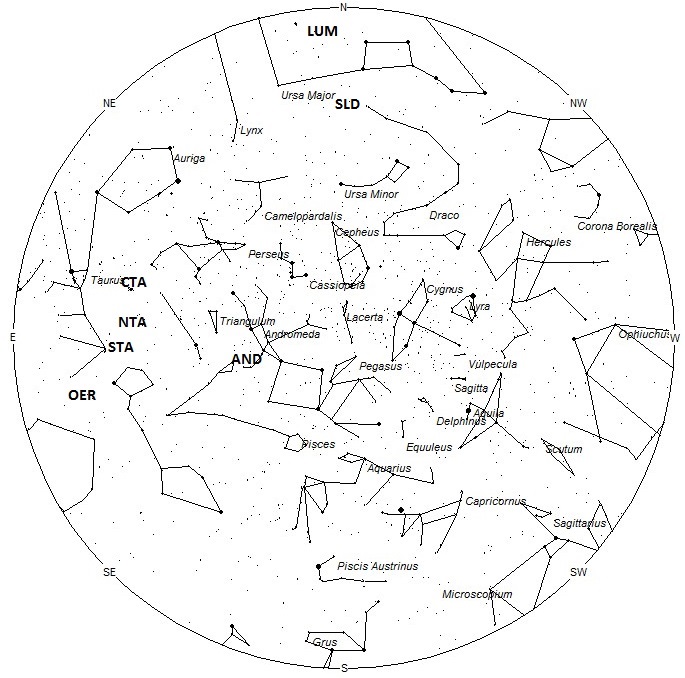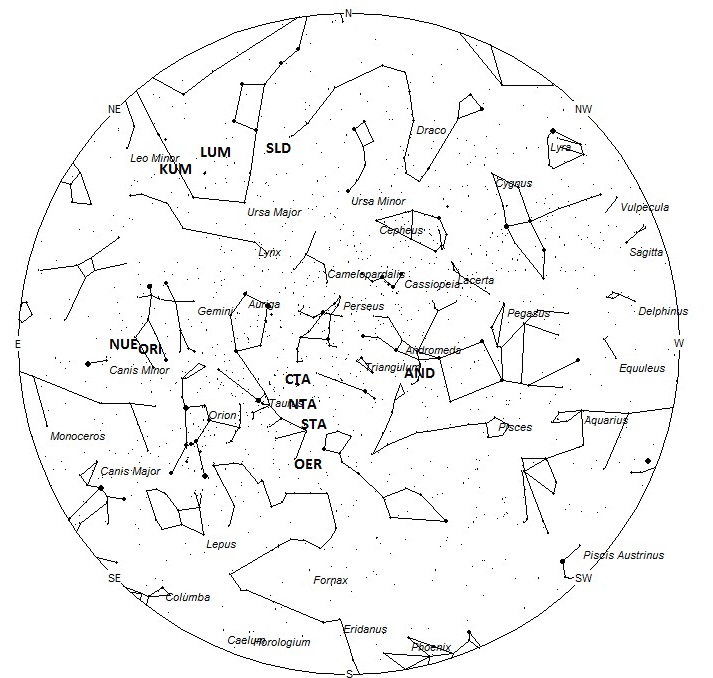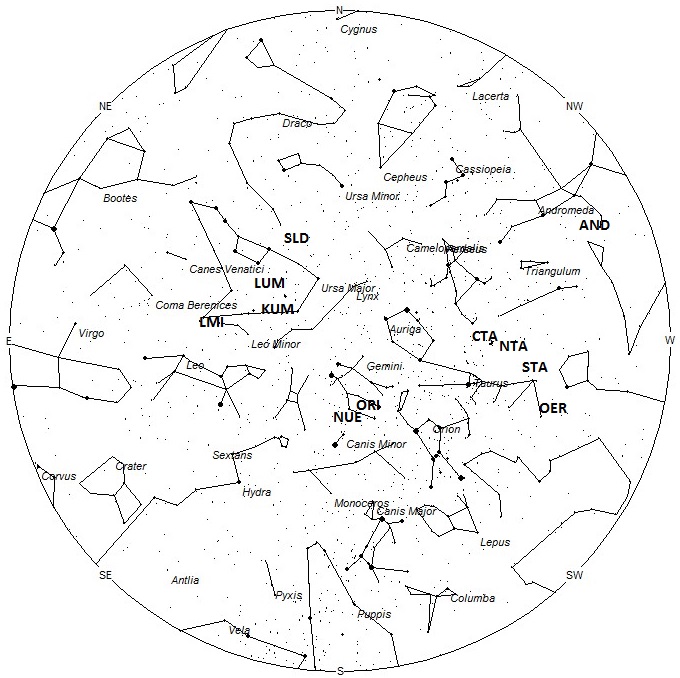
As seen from the northern hemisphere, meteor rates continue to be strong in November. While no major activity is expected this month, the two Taurid radiants plus the Leonids keep the skies active. The addition of strong sporadic rates make November one of the better months to view meteor activity from north of the equator. Skies are fairly quiet as seen from the southern hemisphere this month. Activity from the three showers mentioned above may be seen from south of the equator, but the sporadic rates are much lower than those seen in the northern hemisphere.
During this period the moon will wax from half illuminated to nearly full by the end. Conditions will be favorable this weekend and early next week for viewing meteors in the hours before dawn. Late in the period the moon will become a problem as it is nearing its full phase and will remain is the sky most of the night. The bright moonlight will obscure all but the brighter meteors. The estimated total hourly meteor rates for evening observers this week is near 4 for those viewing from the northern hemisphere and 3 for those located south of the equator. For morning observers the estimated total hourly rates should be near 25 as seen from mid-northern latitudes and 18 from the southern tropics. The actual rates will also depend on factors such as personal light and motion perception, local weather conditions, alertness and experience in watching meteor activity. Evening rates are reduced during this period due to interfering moonlight. Note that the hourly rates listed below are estimates as viewed from dark sky sites away from urban light sources. Observers viewing from urban areas will see less activity as only the brighter meteors will be visible from such locations.
The radiant (the area of the sky where meteors appear to shoot from) positions and rates listed below are exact for Saturday night/Sunday morning October 28/29. These positions do not change greatly day to day so the listed coordinates may be used during this entire period. Most star atlases (available at science stores and planetariums) will provide maps with grid lines of the celestial coordinates so that you may find out exactly where these positions are located in the sky. A planisphere or computer planetarium program is also useful in showing the sky at any time of night on any date of the year. Activity from each radiant is best seen when it is positioned highest in the sky, either due north or south along the meridian, depending on your latitude. It must be remembered that meteor activity is rarely seen at the radiant position. Rather they shoot outwards from the radiant so it is best to center your field of view so that the radiant lies near the edge and not the center. Viewing there will allow you to easily trace the path of each meteor back to the radiant (if it is a shower member) or in another direction if it is a sporadic. Meteor activity is not seen from radiants that are located far below the horizon. The positions below are listed in a west to east manner in order of right ascension (celestial longitude). The positions listed first are located further west therefore are accessible earlier in the night while those listed further down the list rise later in the night.
These sources of meteoric activity are expected to be active this week.
.
The Andromedids (AND) are active from October 26 through November 17 with maximum activity occurring on November 5. The radiant is currently located at 00:55 (014) +25, which lies in northwestern Pisces, 2 degrees north of the 4th magnitude star known as eta Andromedae. Rates should be near 1 per hour as seen from the northern hemisphere and less than 1 as seen from south of the equator. The radiant is best located near midnight local daylight saving time (LDT) when the radiant lies highest above the horizon. With an entry velocity of 18 km/sec., the average Andromedid meteor would be of slow velocity.
The Northern Taurids (NTA) are active from a large radiant located at 02:59 (045) +20. This area of the sky is located in eastern Aries, 3 degrees east of the 4th magnitude star known as Botein (delta Arietis). This position is very close to the Southern Taurids so great care must be taken in separating these meteors. You must have the two radiants near the center of your field of view to properly differentiate these sources. Current rates would be 3 per hour as seen from the northern hemisphere and 2 per hour as seen from south of the equator. These meteors may be seen all night long but the radiant is best placed near 0200 LDT when it lies on the meridian and is located highest in the sky. With an entry velocity of 28 km/sec., the average Northern Taurid meteor would be of slow velocity.
The Southern Taurids (STA) are active from a large radiant centered near 03:12 (048) +13. This position lies in eastern Aries, 7 degrees south of the 4th magnitude star known as Botein (delta Arietis). These meteors may be seen all night long but the radiant is best placed near 0200 LDT when it lies on the meridian and is located highest in the sky. Rates at this time should be near 4 per hour regardless of your location. With an entry velocity of 27 km/sec., the average Southern Taurid meteor would be of slow velocity.
The omicron Eridanids (OER) were discovered by Japanese observers using video data from SonotoCo in 2007-2008. This is a weak shower that usually produces rates less than 1 per hour, even at maximum activity. The radiant is currently located at 03:14 (049) -03, which places it in northwestern Eridanus , 6 degrees southeast of the 3rd magnitude star known as Menkar (alpha Ceti). This location is close to the source of the Southern Taurids so care must be taken to separate these meteors. Like the STA’s these meteors may be seen all night long but the radiant is best placed near 0200 LDT when it lies on the meridian and is located highest in the sky. With an entry velocity of 29 km/sec., the average omicron Eridanid meteor would be of slow velocity.
The chi Taurids (CTA) were discovered by Dr. Peter Brown during his 7 year survey using the Canadian Meteor Orbit Radar (CMOR). This source is active from October 20 through November 17 with a maximum occurring near November 3rd. Current rates should be near 1 per hour as seen from the northern hemisphere and less than 1 as seen from south of the equator. The radiant is currently located at 03:50 (058) +25, which places it in western Taurus , just north of the famous naked eye open cluster known as the Pleiades. This location is close to the source of the Northern Taurids so care must be taken to separate these meteors. These meteors may be seen all night long but the radiant is best placed near 0300 LDT when it lies on the meridian and is located highest in the sky. With an entry velocity of 41 km/sec., the average chi Taurid meteor would be of medium velocity.
The Orionids (ORI) are still active from a radiant located at 06:52 (103) +15, which places it in southern Gemini, 3 degrees east of the 2nd magnitude star known as Alhena (gamma Geminorum). This area of the sky is best placed in the sky near 0500 LDT, when it lies highest above the horizon in a dark sky. Rates should be near 5 per hour no matter your location. With an entry velocity of 67 km/sec., most activity from this radiant would be of swift speed.
The nu Eridanids (NUE) were co-discovered by Japanese observers using SonotoCo and Juergen Rendtel and Sirko Molau of the IMO. Activity from this long-period stream stretches from August 24 all the way to November 16. A very shallow maximum occurred near September 8. The radiant currently lies at 07:20 (110) +13, which places it in southern Gemini, 3 degrees south of the 4th magnitude star known as lambda Geminorum. This area of the sky is best seen during the last dark hour before dawn when the radiant lies highest in a dark sky. This position is also very close the the Orionid radiant and some experts feel that these two sources are related. To separate any possible nu Eridanids from the stronger Orionids one must face in a direction so that both radiant are well within your field of view. Current rates are expected to be less than 1 per hour during this period no matter your location. With an entry velocity of 67 km/sec., the average meteor from this source would be of swift velocity.
The kappa Ursae Majorids (KUM) were discovered by cameras of the SonotaCo network in Japan during an outburst of activity in 2009. This radiant is active from November 3-10 with maximum activity occurring on the 7th. At maximum the radiant is located at 09:49 (147) +45. This position lies in southwestern Ursa Majoris, directly between the 3rd magnitude stars known as lambda and iota Ursae Majoris. Rates, even at maximum, are expected to be less than 1 regardless of your location. These meteors are best seen during the last hour before dawn when the radiant lies highest above the horizon in a dark sky. With an entry velocity of 66 km/sec., the average Kappa Ursae Majorid meteor would be of swift velocity.
The Lambda Ursae Majorids (LUM) are a recent discovery by Željko Andreić and the Croatian Meteor Network team based on studying SonotaCo and CMN observations (SonotaCo 2007-2011, CMN 2007-2010). This shower is active from October 24 through November 1st with maximum activity occurring on the 27th. At maximum the radiant is located at 10:31 (158) +50. This position lies in a sparse area of central Ursa Major, between the 2nd magnitude star Merak (Beta Ursae Majoris) and 3rd magnitude Tania Borealis (Lambda Ursa Majoris). This area of the sky is best placed in the sky during the last hour before dawn, when it lies highest above the horizon in a dark sky. Rates at maximum should be near 1 per hour as seen from the northern hemisphere and less than 1 as seen from south of the equator. With an entry velocity of 62 km/sec., most activity from this radiant would be of swift speed.
The Southern lambda Draconids (SLD) are also recent discovery by Željko Andreić and the Croatian Meteor Network team based on studying SonotaCo and CMN observations (SonotaCo 2007-2011, CMN 2007-2010). This shower is active from November 1-4 with maximum activity occurring on the 3rd. At maximum the radiant is located at 10:48 (162) +68. This position lies in northwestern Ursa Major, 7 degrees north of the 2nd magnitude star known as Dubhe (alpha Ursae Majoris). This area of the sky is best placed in the sky during the last hour before dawn, when it lies highest above the horizon in a dark sky. Rates at maximum are expected to be less than 1 per hour no matter your location. With an entry velocity of 49 km/sec., most activity from this radiant would be of medium-swift speed.
The Leonis Minorids (LMI) are active from October 12-Nov 5 with maximum activity occurring on October 22nd. This radiant is currently located at 11:08 (167) +34, which places it in southern Ursa Majoris, 3 degrees west of the 3rd magnitude star known as Alula Borealis (nu Ursae Majoris). The radiant is best placed just before dawn when it lies highest in a dark sky. This shower is better situated for observers located in the northern hemisphere where the radiant rises far higher into the sky before the start of morning twilight. Current rates would be near 1 per hour for observers viewing from the northern hemisphere and less than 1 for those located south of the equator. At 62km/sec., the average Leonis Minorid is swift. From my personal experience this minor shower produces a high proportion of bright meteors.
As seen from the mid-northern hemisphere (45N) one would expect to see approximately 10 sporadic meteors per hour during the last hour before dawn as seen from rural observing sites. Evening rates would be near 3 per hour. As seen from the tropical southern latitudes (25S), morning rates would be near 7 per hour as seen from rural observing sites and 2 per hour during the evening hours. Locations between these two extremes would see activity between the listed figures. Evening rates are reduced during this period due to moonlight.
The list below offers the information from above in tabular form. Rates and positions are exact for Saturday night/Sunday morning except where noted in the shower descriptions.
| SHOWER | DATE OF MAXIMUM ACTIVITY | CELESTIAL POSITION | ENTRY VELOCITY | CULMINATION | HOURLY RATE | CLASS |
| RA (RA in Deg.) DEC | Km/Sec | Local Daylight Saving Time | North-South | |||
| Andromedids (AND) | Nov 05 | 00:55 (014) +25 | 18 | 00:00 | 1 – <1 | III |
| Northern Taurids (NTA) | Nov 02 | 02:59 (045) +20 | 28 | 02:00 | 3 – 2 | II |
| Southern Taurids (STA) | Oct 29-Nov 03 | 03:12 (048) +13 | 27 | 02:00 | 4 – 4 | II |
| omicron Eridanids (OER) | Nov 04 | 03:14 (049) -03 | 29 | 02:00 | <1 – <1 | IV |
| chi Taurids (CTA) | Nov 03 | 03:50 (058) +25 | 41 | 03:00 | 1 – <1 | IV |
| Orionids (ORI) | Oct 22 | 06:52 (103) +15 | 67 | 05:00 | 5 – 5 | I |
| nu Eridanids (NUE) | Sep 08 | 07:20 (110) +13 | 67 | 06:00 | <1 – <1 | IV |
| kappa Ursae Majorids (KUM) | Nov 07 | 09:49 (147) +45 | 66 | 08:00 | <1 – <1 | IV |
| Lambda Ursae Majorids (LUM) | Oct 27 | 10:31 (158) +50 | 62 | 09:00 | <1 – <1 | IV |
| Southern lambda Draconids (SLD) | Nov 03 | 10:48 (162) +68 | 49 | 09:00 | 1 – <1 | II |
| Leonis Minorids (LMI) | Oct 22 | 11:08 (167) +34 | 62 | 10:00 | 1 – <1 | II |
 American Meteor Society
American Meteor Society



I saw something one night anywhere from 9p-11pm cant be exact but it was Not a shooting star! it was a huge blue ball with hot pink, red, yellow, &green around it and it had a tail like a comet white stars and fire. it was the most amazing thing I have ever seen as far as stars go. I’m not sure if it was a comet or what, but it appeared to be very close to the earth. This sighting was in Tennessee.
Saw something very similar to what was explained above tonight. Didn’t appear to be too high or traveling too fast. large cone shaped outline or maybe more like a large snake she with a large head which was red and yellow and it appeared to be on fire but difficult to really tell. Distinctive glow to the head/front. Saw it cross southeast to northwest going over the Central Florida area at about 10pm. Anyone have any idea what I saw. I was stone sober and not suffering from any trauma or illness. It was there and I have never seen anything like it. Wild…..